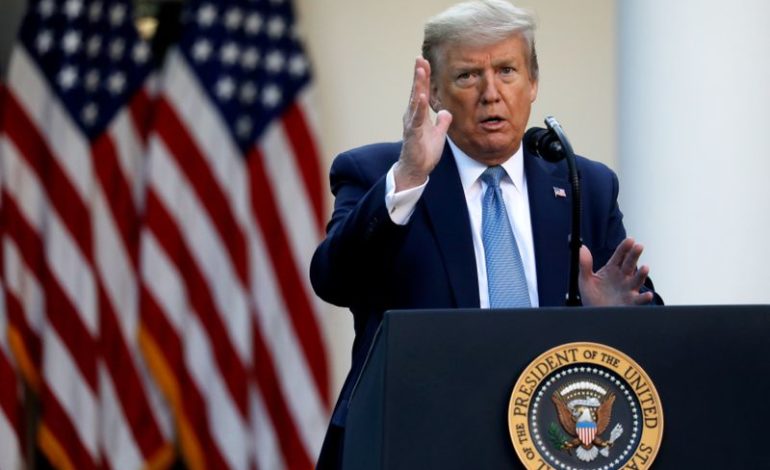WASHINGTON — Parts of President Trump’s guidelines for re-opening the U.S. economy amid the coronavirus pandemic surfaced on Thursday afternoon, revealing a three-phase plan that could allow some states to begin as early as this month to begin lifting limits meant to contain the spread of the virus.
In the first phase, larger venues like restaurants and movie theaters could operate again with strict social distancing, according to a copy of the guidelines seen by Reuters.
Non-essential travel could resume and schools could open up again in phase two. In phase three, medically vulnerable people could resume public interactions.
“We are not opening all at once, but one careful step at a time,” Trump said, adding that some states will be able to open up sooner than others, to be done at each governor’s discretion.
Reopenings could be done on a statewide or county-by-county basis, depending on statistics involving the spread of the disease. Instead of a blanket shutdown, the country will focus on sheltering people most at-risk from the pandemic, such as those with preexisting conditions and the elderly.
No timeline was put on the unfolding of these phases according to Dr. Deborah Birx, the White House’s coronavirus response coordinator.
In a document provided to all state governors during a phone call on Thursday, cited by CNN, the White House revealed that benchmarks include a sustained decrease in cases over a 14-day period and also that a return to pre-crisis conditions in hospitals should be observed before social distancing guidelines could possibly be relaxed.
States should also focus on the “ability to quickly set up safe and efficient screening and testing sites” and to be able to “quickly and independently supply sufficient personal protective equipment” in hospitals.
According to a report from the New York Times, Trump told some governors that their states could open as soon as May 1.
In a tweet released Thursday, Ohio governor Mike DeWine said his state was optimistic about getting back to work, as he appeared to target the date for reopening of its economy as part of a coalition of Midwest governors, including Gretchen Whitmer of Michigan.
Record 22 million Americans file for unemployment as coronavirus ravages U.S. economy
Meanwhile, pressure has been mounting to save the U.S. economy from a looming catastrophe.
A record 22 million Americans have sought unemployment benefits over the past month, with millions more filing claims last week, almost wiping out all the job gains since the Great Recession as governors everywhere have enforced stay-at-home edicts during the coronavirus crisis.
Data released on Thursday showed that manufacturing activity in the mid-Atlantic region plunged to levels last seen in 1980 and home building tumbled to levels not seen in 36 years in the month of March.
The reports followed a record drop in the retail sector in March due to forced government closures and a lack of spending capital among consumers, along with the largest decline in factory output since 1946.
“The scale of job losses we have had in the past four weeks is remarkable, nearly all the jobs gained since Great Financial Crisis are now lost,” said James Knightley, chief international economist at ING New York.
In total, 22.034 million people have filed claims for jobless benefits since March 21, representing about 13.5 percent of the labor force. Employment bottomed at around 138 million in December 2010 and peaked at 158.8 million in February.
The staggering numbers set the stage for job losses of more than 1 million in April, according to a report from Reuters.
Claims are expected to be in the millions against next week, according to Gus Faucher, chief economist at PNC Financial in Pittsburgh, Pennsylvania.
In a separate report filed on Thursday, the Commerce Department said housing starts plunged 22.3 percent to a seasonally adjusted annual rate of 1.216 million units last month, the largest monthly decline in starts since March 1984.
“The economy is in a downward spiral where job losses beget job losses and the federal government emergency relief checks will not be enough to turn the tide,” said Chris Rupkey, chief economist at MUFG in New York.
“The recovery is looking less V-shaped by the day as the deeper we fall, the harder it will be for the nation to climb back out of this deep hole the pandemic has dug for the economy. The worst is yet to come.”






Leave a Reply